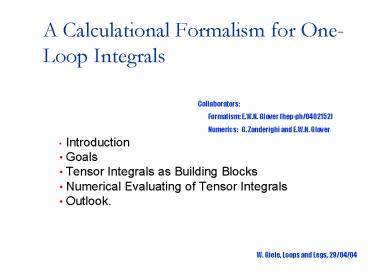A Calculational Formalism for OneLoop Integrals - PowerPoint PPT Presentation
Title:
A Calculational Formalism for OneLoop Integrals
Description:
A Calculational Formalism for One-Loop Integrals. Introduction. Goals ... W. Giele, Loops and Legs, 29/04/04. Collaborators: Formalism: E.W.N. Glover (hep-ph/0402152) ... – PowerPoint PPT presentation
Number of Views:50
Avg rating:3.0/5.0
Title: A Calculational Formalism for OneLoop Integrals
1
A Calculational Formalism for One-Loop Integrals
Collaborators Formalism E.W.N. Glover
(hep-ph/0402152) Numerics G.
Zanderighi and E.W.N. Glover
- Introduction
- Goals
- Tensor Integrals as Building Blocks
- Numerical Evaluating of Tensor Integrals
- Outlook.
W. Giele, Loops and Legs, 29/04/04
2
Introduction
- We need NLO for
- First estimate of normalization
- Better understanding of shape of distributions
3
Goals
- An automated evaluation of one loop virtual
contributions - The number of external legs should be limited by
computer resources - No numerical integration in loop space but
numerical reduction to basis set of integrals
For pure numerical approaches see G.J. van
Oldenborgh J.A.M. Vermaseren 1990 D.Soper
2000 D. Soper Z. Nagy 2003
4
Tensor Integrals as Building Blocks
- Any one-loop amplitude can be decomposed
inwhere the tensor integral is given byand
5
- The calculation of the tensor integral causes
algebraic problems - Next we would express the coefficients into
scalar integrals - As we increase the number of external lines this
quickly becomes unmanageable
6
- For example the 6 photon amplitude is a sum over
the different permutations of - This goes up to rank 6 six-point tensor integrals
- The rank 6 on itself would create 49 terms
likefor which we need determine the coefficient
in terms of scalar integrals and evaluate
7
- Clearly for an automated evaluation of loop
graphs we need to numerically evaluate the tensor
integrals - This leaves us only with the calculation of the
coefficient for each rankwhere the tensor
integrals are symmetric
8
Numerical Evaluating of Tensor Integrals
(See also A. Ferroglia, M. Passera, G. Passarino
S. Uccirati, 2003
F. del Aguila R.Pittau, 2004)
- To accomplish this we need to
- Separate the divergent part of the tensor
integral - Calculate the finite part numerical
- Calculate the divergent part algebraic (if not
known)E.g. the leading color divergent part of a
color ordered amplitude is simply(this
requires a careful definition of finite)
9
- The decomposition to generalized scalars does
fulfill all the requirements (Davydychev 1991) - It translates a tensor integral into higher
dimensional scalar integrals. E.g. - If we can numerically evaluate the scalar
integralswe can numerically construct the
tensor integral
10
- A recursive scheme to calculate
is well established in the literature - Recursion relations between scalar integrals have
been known for a long time in 4 dimensions
(Melrose 1965W.L. van Neerven J.A.M.
Vermaseren 1984) - The extension to arbitrary dimensions was first
formalized by Z. Bern, L.J. Dixon D.A. Kosower
1993 - And further developed by many groups into the
formulation we will use (O.V. Tarasov 1996 J.M.
Campbell, E.W.N. Glover and D.J. Miller 1997 J.
Fleischer, F. Jegerlehner O.V. Tarasov 2000
T. Binoth, J.P. Guillet G. Heinrich 2000 G.
Duplancic B. Nizic 2003)
11
- The basic identity behind the recursion relations
is the integration by part identity (K.G.
Chtyrkin, A.L. Kataev F.V. Tkachov 1980) - This leads to the base equation (for
)
Evaluated numerical
12
- Sequential application of recursive relations
eventually lead to a basis set of known
integrals - The 4-dimensional finite part is calculated by
the numerical recursion algorithm - The divergent part is either known or calculated
by the singular decomposition
Only UV/IR divergent2- and 3-pointintegrals
No dimensional dependence
13
14
- We need to be able to calculate the divergent
contribution analytical - For this we extended a method (S. Dittmaier,
2003) to work with tensor integrals. - The singular decomposition decomposes a tensor
integral instantaneously into a sum over
divergent triangles
Finite parts of triangles in numerical part
15
G. Zanderighi, W.G E.W.N. Glover
- We are currently implementing the recursion
algorithm up to 6 external legs (including
arbitrary mass configurations)
Analytic
Recursive
16
Outlook
- We have constructed an explicit algorithmic
method to calculate NLO corrections to processes
with large number of legs - A numerical evaluation of the finite part of rank
m N-point tensor integrals - An analytic singular decomposition to 3-point
functions for rank m N-point tensor integrals - We are in the middle of implementing the
algorithm for arbitrary masses configurations - This will lead shortly to first applications,
e.g.
17
(No Transcript)

